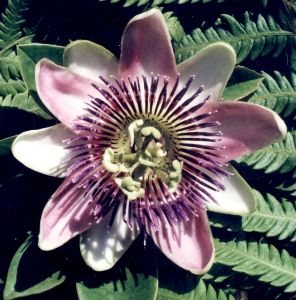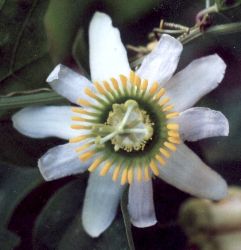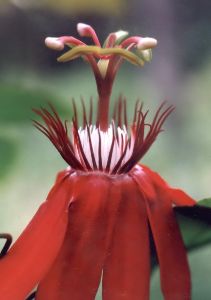Passionflowers
by Valerie (June 14, 2000)
revised August 29, 2003
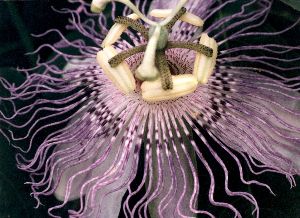
The exotic-looking flower pictured at left is actually one of our most common garden flowers: the purple passionflower (Passiflora sp.). After planting some seeds I received from Florida, one fragile plant sprouted. By the following year, the underground runners from the original plant had spread out by over six feet and now they come up all over our yard. I try to encourage the sprouts in the gardens by giving them extra water and discourage those in the lawn by cutting them off. Sometimes it works. 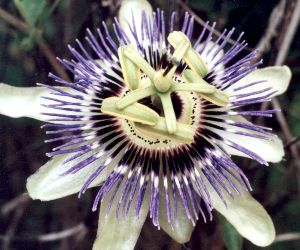
Our accomodation of vines is rather haphazard: we let them grow over the compost bins, on all the fences, sometimes on the trees and shrubs, and, in special cases, in the gardens with the other plants. I like the passionflowers so much that they are allowed to grow over almost everything. When a sprout initially emerges from one of the underground stems, it is very easily broken, and then might sprout somewhere else. After a plant has grown all summer from one place, it forms a tuber at the base and then is likely to sprout there again the following year, but it's not guaranteed.
Our vines often only produce a few fruits, and these only appear late in the summer and, taking quite a while to mature, sometimes don't ripen before a freeze kills them. The ripe fruits are about two inches long, smooth and yellow. They smell heavenly. Inside, there is not much except for seeds with a slimy gelatinous coating. The coating tastes great, but there's not much of it, and the seeds are so big that I don't like to swallow them, but the combination of smell and flavor makes them hard to resist.
The tendrils that help the vines climb grow very quickly and when one touches anything, it starts to wrap around. It does this in a matter of hours. In fact, the vines themselves grow very quickly, especially our common passionvine, up until the first frost. Once frozen, the vines die back to the ground. We have one other species of passionflower that does well and it is an evergreen type. While our deciduous plants have huge three-lobed leaves, this other kind has smaller, more delicate five-lobed foliage. The stems are also thinner and woodier. The flowers are white and have a bluish tinge so that they are sometimes called blue passionflowers. This plant was started from a nursery seedling, and I had a second, which froze out when it was small.
I tried to grow one other passionflower, which didn't survive its first winter but did produce lovely pink and white flowers. Its leaves were not lobed. Other species grow in this area, including a closely-related different type of purple passionflower, which has more delicate leaves with five lobes and darker-colored flowers. The tiny white-blossom passionflower has a woody stem and small leaves. The very striking red passionflower is not very cold-hardy and so must be protected. The name "passionflower" comes from the association of the parts of the blossom to the story of Christ's last hours, or the "Passion of Christ." The 3-pronged pistil represents the nails used in the crucifixion, 5 stamens are the wounds, the corona is the "crown of thorns" and the 10 sepals and petals are the apostles, minus Peter and Judas. Other names for passionflowers include bell apple, water lemon, maypop and apricot vine. |
